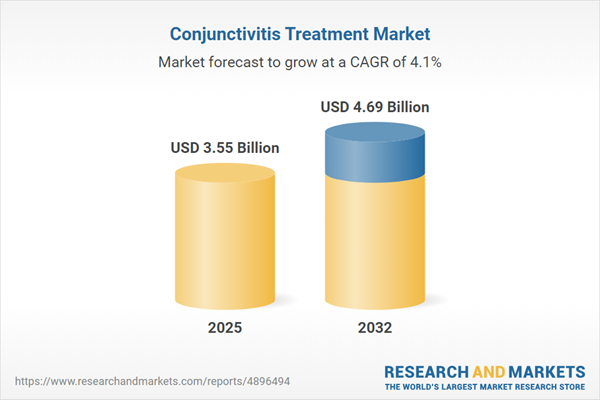Speak directly to the analyst to clarify any post sales queries you may have.
The conjunctivitis treatment market is transforming quickly as industry leaders respond to advancing therapies, evolving patient expectations, and a complex global operating environment. This report equips healthcare executives with actionable analysis to inform investment, product, and regional strategies for sustainable growth.
Market Snapshot: Conjunctivitis Treatment Market Size and Growth
The conjunctivitis treatment market grew from USD 3.41 billion in 2024 to USD 3.55 billion in 2025 and is projected to expand at a CAGR of 4.05%, reaching USD 4.69 billion by 2032. Progress in the conjunctivitis treatment market is driven by the convergence of clinical advancements, regulatory changes, and strategic industry realignments, positioning it as a high-potential segment within the broader ophthalmology sector.
Scope & Segmentation
This report delivers an in-depth segmentation analysis and robust coverage of all key market variables:
- Drug Class: Antibiotics, Antihistamines, Antivirals, Combination Therapy, Corticosteroids, Decongestants, Ocular Lubricants
- Distribution Channel: Offline, Online Pharmacy, Direct E-Retailer, Third-Party Marketplace
- End User: Clinics, Home Healthcare, Hospitals, Pharmacies
- Disease Type: Allergic, Bacterial, Viral
- Route of Administration: Injectable, Topical
- Region: Americas (including United States, Canada, Mexico, Brazil, Argentina, Chile, Colombia, Peru), Europe, Middle East & Africa (including United Kingdom, Germany, France, Russia, Italy, Spain, Netherlands, Sweden, Poland, Switzerland, United Arab Emirates, Saudi Arabia, Qatar, Turkey, Israel, South Africa, Nigeria, Egypt, Kenya), Asia-Pacific (including China, India, Japan, Australia, South Korea, Indonesia, Thailand, Malaysia, Singapore, Taiwan)
- Key Companies: Alcon Inc., Bausch Health Companies Inc., AbbVie Inc., Santen Pharmaceutical Co., Ltd., Pfizer Inc., Merck & Co., Inc., Johnson & Johnson Consumer Inc., Novartis International AG, GlaxoSmithKline plc, Teva Pharmaceutical Industries Ltd.
Technological analysis includes innovation in sustained-release platforms, nanoparticle-based therapies, and teleophthalmology deployments, reflecting cutting-edge trends in patient care and disease management.
Key Takeaways for Healthcare Decision Makers
- New drug delivery systems raise expectations for patient adherence and reduced dosing frequency, supporting operational efficiency in clinical practice.
- Digital health adoption, including telemedicine and symptom tracking, is shifting care from hospital-centric to more decentralized and home-based models.
- Reimbursement negotiations are intensifying, prompting greater emphasis on evidence-driven formulations and pharma-provider collaboration to demonstrate differentiated outcomes.
- Variations in regulatory structures, access, and disease burdens across regions require tailored approaches to product launches, pricing, and distribution.
- Competitive dynamics are shaped by generics, biosimilars, and mergers, requiring manufacturers to innovate in both product attributes and go-to-market strategies.
- Collaboration between manufacturing organizations, clinical researchers, and distributors is enabling scalable supply and faster technology adoption.
Tariff Impact: Navigating US Regulatory and Supply Chain Pressures
Recent US tariffs have increased raw material and component costs, prompting industry leaders to diversify supply chains and consider regional manufacturing. These measures have led to more complex reimbursement negotiations and fostered adoption of group purchasing or alliance models to stabilize pricing and ensure reliable access to therapies. Proactive management of these headwinds remains essential to maintain margin stability and supply resilience.
Methodology & Data Sources
This analysis combines primary interviews with key opinion leaders, a comprehensive review of clinical, regulatory, and business publications, and advanced quantitative modeling. Findings are validated through multi-stage expert peer review, delivering a balanced, evidence-led assessment for strategic decision-making.
Why This Report Matters
- Enables strategic planning based on detailed market and segment insights, supporting precise targeting and competitive differentiation in the conjunctivitis treatment market.
- Empowers executives to proactively address regulatory, operational, and supply risks in a changing global landscape.
- Supports innovation and investment by illuminating pathways for partnership, market access, and future pipeline development.
Conclusion
Market success in conjunctivitis care will depend on a coherent mix of clinical innovation, strategic agility, and collaborative execution. Industry leaders equipped with timely intelligence can capitalize on evolving opportunities and manage emerging risks across this dynamic sector.
Additional Product Information:
- Purchase of this report includes 1 year online access with quarterly updates.
- This report can be updated on request. Please contact our Customer Experience team using the Ask a Question widget on our website.
Table of Contents
3. Executive Summary
4. Market Overview
7. Cumulative Impact of Artificial Intelligence 2025
Companies Mentioned
The companies profiled in this Conjunctivitis Treatment market report include:- Alcon Inc.
- Bausch Health Companies Inc.
- AbbVie Inc.
- Santen Pharmaceutical Co., Ltd.
- Pfizer Inc.
- Merck & Co., Inc.
- Johnson & Johnson Consumer Inc.
- Novartis International AG
- GlaxoSmithKline plc
- Teva Pharmaceutical Industries Ltd.
Table Information
| Report Attribute | Details |
|---|---|
| No. of Pages | 192 |
| Published | November 2025 |
| Forecast Period | 2025 - 2032 |
| Estimated Market Value ( USD | $ 3.55 Billion |
| Forecasted Market Value ( USD | $ 4.69 Billion |
| Compound Annual Growth Rate | 4.0% |
| Regions Covered | Global |
| No. of Companies Mentioned | 11 |









